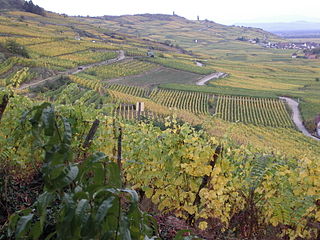
Alsace wine or Alsatian wine is produced in the Alsace region in France and is primarily white wine. Because of its Germanic influence, it is the only Appellation d'Origine Contrôlée region in France to produce mostly varietal wines, typically from similar grape varieties to those used in German wine. Along with Austria and Germany, it produces some of the most noted dry Rieslings in the world as well as highly aromatic Gewürztraminer wines. Wines are produced under three different AOCs: Alsace AOC for white, rosé and red wines, Alsace Grand Cru AOC for white wines from certain classified vineyards and Crémant d'Alsace AOC for sparkling wines. Both dry and sweet white wines are produced.

Banyuls is a French appellation d'origine contrôlée (AOC) for a fortified apéritif or dessert wine made from old vines cultivated in terraces on the slopes of the Catalan Pyrenees in the Roussillon county of France, bordering, to the south, the Empordà wine region in Catalonia in Spain.
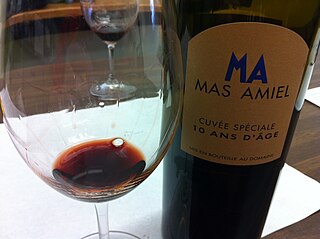
Maury is an Appellation d'Origine Contrôlée (AOC) for fortified vin doux naturel wines made in the Roussillon wine region of France. Almost all wines are red, made from at least 75% Grenache noir (Garnacha). Other permitted grapes are Grenache blanc, Grenache gris, Macabeu (Macabeo), Malvoisie du Roussillon (Tourbat), Syrah, Muscat and other local varieties. Although the grapes are different, they are used and marketed very much like port. It is made in the communes of Maury, Saint-Paul-de-Fenouillet, Lesquerde, Tautavel and Rasiguères. The AOC was granted in 1936.
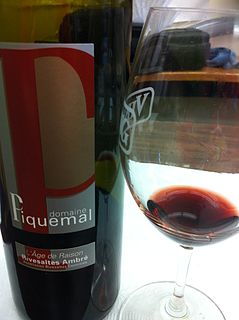
Rivesaltes is an Appellation d'Origine Contrôlée for naturally sweet, fortified wines made in the Languedoc-Roussillon wine region of France. They are similar to Muscat de Rivesaltes AOC wines, except the grape varieties are not restricted to Muscat. The wines are red or white, and made from Muscat, Grenache noir, Grenache blanc, Grenache gris, Macabeu and (rarely) Malvoisie grapes.

Rasteau is an Appellation d'Origine Contrôlée for wine in the southern Rhône wine region of France, covering both fortified and unfortified wines. The sweet fortified wines can be red, rosé or white, and have long been produced under the Rasteau AOC. In 2010 dry red wines (unfortified) were also added to the appellation, effective from the 2009 vintage.

Languedoc-Roussillon wine, including the vin de pays labeled Vin de Pays d'Oc, is produced in southern France. While "Languedoc" can refer to a specific historic region of France and Northern Catalonia, usage since the 20th century has primarily referred to the northern part of the Languedoc-Roussillon région of France, an area which spans the Mediterranean coastline from the French border with Spain to the region of Provence. The area has around 700,000 acres (2,800 km2) under vines and is the single biggest wine-producing region in the world, being responsible for more than a third of France's total wine production. In 2001, the region produced more wine than the United States.
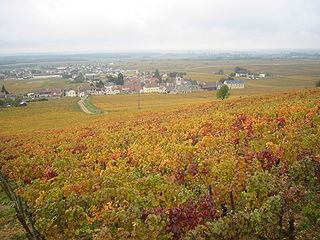
Clos Saint-Denis is an Appellation d'origine contrôlée (AOC) and Grand Cru vineyard for red wine in the Côte de Nuits subregion of Burgundy, with Pinot noir as the main grape variety. It is situated in the commune of Morey-Saint-Denis in the Côte-d'Or département. Clos de la Roche is located just to the north of the village Morey-Saint-Denis and borders to the Grand Cru vineyard Clos de la Roche in the north. The AOC was created in 1936, and the Clos part of its name refers to a wall-enclosed vineyard.
Sélection de Grains Nobles (SGN) is French for "selection of noble berries" and refers to wines made from grapes affected by noble rot. SGN wines are sweet dessert wines with rich, concentrated flavours. Alsace wines were the first to be described as Sélection de Grains Nobles, with the legal definition introduced in 1984, but the term is also seen in some other wine regions France, such as Loire.
Mazoyères-Chambertin is an Appellation d'origine contrôlée (AOC) and Grand Cru vineyard for red wine in the Côte de Nuits subregion of Burgundy, with Pinot noir as the main grape variety. Mazoyères-Chambertin is located within the commune of Gevrey-Chambertin. It is situated below the Route des Grands Crus. It borders on Latricières-Chambertin and the Gevrey-Chambertin Premier Cru aux Combottes in the west, Charmes-Chambertin in the north, Gevrey-Chambertin village level vineyards in the east, and Morey-Saint-Denis Premier Cru vineyards in the south. The AOC was created in 1937.

The wine region of Alsace produces wines under three different Appellations d'Origine Contrôlées (AOCs): Alsace AOC for white, rosé and red wines, Alsace Grand Cru AOC for white wines from certain classified vineyards and Crémant d'Alsace AOC for sparkling wines. This region is the only French wine region allowed to label its wines based on variety.
Chambolle-Musigny wine is produced in the village of Chambolle-Musigny in Côte de Nuits of Burgundy. The Appellation d'origine contrôlée (AOC) Chambolle-Musigny may only be used for red wine with Pinot noir as the main grape. There are 25 Premier Cru vineyards in Chambolle-Musigny, and two Grand Cru vineyards: Musigny and Bonnes Mares. The AOC was created in 1936.
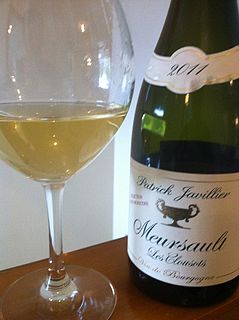
Meursault wine is produced in the commune of Meursault in Côte de Beaune of Burgundy. The Appellation d'origine contrôlée (AOC) Meursault may be used for white wine and red with respectively Chardonnay and Pinot noir as the main grape varieties. The production of white Meursault dominates, with around 98 per cent. There are no Grand Cru vineyards within Meursault, but several highly regarded Premier Cru vineyards.
Blagny is an appellation d'origine contrôlée (AOC) for red wine from Pinot noir produced in the communes of Meursault and Puligny-Montrachet in Côte de Beaune of Burgundy. The appellation only covers seven Premier Cru-classed climats in the two communes, and takes its name from a small village in Puligny-Montrachet situated just on the commune border to Meursault. The AOC was created in 1970.

Pommard wine is produced in the commune of Pommard in Côte de Beaune of Burgundy. The Appellation d'origine contrôlée (AOC) Pommard is only used for red wine with Pinot noir as the main grape variety. There are no Grand Cru vineyards within Pommard, but several highly regarded Premier Cru vineyards. The AOC was created in 1937.
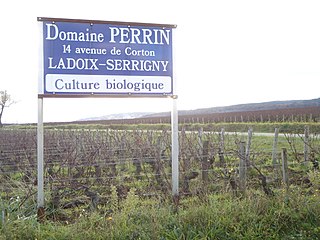
Ladoix wine is produced in the commune of Ladoix-Serrigny in Côte de Beaune of Burgundy, France. The Appellation d'origine contrôlée (AOC) Ladoix may be used for red and white wine with respectively Pinot noir and Chardonnay as the main grape variety. The production consists of around three-quarter red wine, and around one-quarter white wine. The northeastern part of the Corton hill is located in the commune of Ladoix-Serrigny, including vineyards of two of the three Grand Cru AOCs of the hill, Corton and Corton-Charlemagne. Some of the Premier Cru vineyards of Ladoix-Serrigny are part of the Aloxe-Corton AOC of the neighbouring village rather than of Ladoix AOC, and vinified and sold as Aloxe-Corton Premier Cru.

Chorey-les-Beaune wine is produced in the commune of Chorey-les-Beaune in Côte de Beaune of Burgundy. The Appellation d'origine contrôlée (AOC) Chorey-les-Beaune, which may also be written Chorey, may be used for red and white wine with respectively Pinot noir and Chardonnay as the main grape variety. More than 90 per cent of the production consists of red wine. There are no Grand Cru and no Premier Cru vineyards within Chorey-les-Beaune wine. Chorey-les-Beaune wine is sometimes declassified to Côte de Beaune-Villages, which is an appellation that allow négociants to sell wine blended from several villages. The AOC was created in 1970.
Pouilly-Loché is an Appellation d'Origine Contrôlée (AOC) for white wine in the Mâconnais subregion Burgundy in central France, located in the commune of Loché, an associated commune of Mâcon. Pouilly-Loché has Chardonnay as the only allowed grape variety. There are no Premier Cru vineyards within the AOC, as the local growers at the time the regulations were being drawn up never applied for this. The AOC was created in 1940.
Pouilly-Vinzelles is an Appellation d'Origine Contrôlée (AOC) for white wine in the Mâconnais subregion Burgundy in central France, located in the communes of Vinzelles and Loché, the latter an associated commune of Mâcon. Pouilly-Vinzelles has Chardonnay as the only allowed grape variety. There are no Premier Cru vineyards within the AOC, as the local growers at the time the regulations were being drawn up never applied for this. The AOC was created in 1940.

Viré-Clessé is an Appellation d'Origine Contrôlée (AOC) for white wine in the Mâconnais subregion in Burgundy in central France, located in the communes of Clessé, Laizé, Montbellet and Viré. Viré-Clessé has Chardonnay as the only allowed grape variety. There are no Premier Cru vineyards within the AOC. The AOC was created in 1999, when this area was upgraded to be a communal-level appellation of its own rather than being part of the subregional Mâcon AOC, which covers a much larger area. Before the Viré-Clessé AOC was created, the wines could be labelled Mâcon-Vire or Mâcon-Clessé.



















